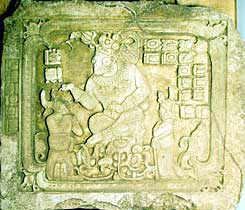Additional revelations about the cultural power of the Mayans

For the archaeologists excavating the remote Mayan ruins in the jungles of Guatemala, this has been an especially good digging season. Under the royal palace in the old city of Vaca, a rare discovery awaited them: the tomb of the Mayan queen, who died more than 1,200 years ago. The royal skeleton was found resting on a stone bed and surrounded by symbols of wealth and power - pearls, black volcanic stone, carved jade stones from the royal crown and remains of what appears to be the queen's battle helmet.
In the city of Kankuan, from the eighth century AD, archaeologists uncovered a stone tablet decorated with magnificent paintings and inscriptions carved in relief. According to experts, the tablet, which depicts ceremonies in the royal playground, is a masterpiece of Mayan art.
In the ruins of another ancient city, archaeologists have found new evidence that the Mayan culture excelled in splendor and cultural complexity hundreds of years before what was estimated. By 150 BC the city of Siwal had many of the characteristics of the later classical period: kings, complex iconography, script and impressive ceremonial architecture.
According to the researchers, the new discoveries promise to provide insights into the final heyday of the Mayan civilization's classic period, which ended around 900 AD. Following the discoveries, the researchers speculate that the estimates of the beginning of the period - which is now dated around 250 AD - will be updated to an earlier date. Now the last centuries of the pre-classical period can no longer be characterized as a culture based mostly entirely on simple peasant villages.
Guatemalan government officials announced earlier this month the finds in Vaca and Siwal, which were discovered by excavation teams from Southern Methodist University in Dallas and Vanderbilt University in Nashville. Another group from Vanderbilt reported last month on the new findings in Canquan.
The Maya, which was one of the most magnificent pre-Columbian civilizations, flourished throughout Central America, especially in Guatemala and southern Mexico where towering pyramid cities and wide plazas can be found. Almost all the cities were already ruins that were taken over by the jungle when the Spanish landed in the area at the beginning of the 16th century.
Vaca, in northwest Guatemala, seems to have reached the height of its power in the Classic period, in the years 800-400 AD. In February, David Lee, a graduate student at Southern Methodist, dug a trench in the city's palace. Suddenly, while digging, he broke an opening through the ceiling of a tomb. "We were surprised," said Dr. David Friedel, a lecturer in anthropology at Southern Methodist. "We didn't look for a tomb there, because usually the tombs of kings are found in pyramids and not in palaces."
In the grave - 3.3 meters long, 1.5 meters wide and 1.8 meters high - the archaeologists found a female skeleton, without the skull and thigh bones. According to them, these parts may have been separated from the skeleton in a ritual ceremony.
The researchers found no clues to the woman's name or age, but according to the pottery found in the tomb, it is estimated that she lived between 650 and 750 AD. Other tools found testify to her high social status. Thus, for example, the head of an idol carved from jade reminded archaeologists of the type of gems that Mayan kings used to set in their crowns. Other jade vessels found appeared to be part of a battle helmet. According to the researchers, the presence of such tools in the tomb of the leader supports the hypothesis that in the ancient Maya culture there was sometimes a mixing of gender roles.
Spines of trigon fish were also found in the grave, which aroused great curiosity. It is known that the Mayan kings used to use such spines to pierce their genitals, in rituals in which they bled to death as a sacrifice to the gods.
Elsewhere, archaeologists found a stone monument with a carved portrait of Queen Mwaka, who reigned around the same time. In the address she is referred to as "the leader of the supreme war". According to the archaeologists, it is not clear if the skeleton of the woman found in the tomb is indeed the skeleton of the queen. "The tomb will help us understand how women shared power with men in controlling their kingdoms," said Dr. Freidel, who is managing the excavation project along with Dr. Hector Escobedo from the University of San Carlos in Guatemala.
Also in Cancuen, on the Passion River in northern Guatemala, stone monuments provided fascinating discoveries. The excavations at the site are being conducted under the direction of Dr. Arthur Demarest from Vanderbilt University. While excavating the royal playground, archaeologists discovered an altar stone depicting the eighth-century great king, Taj Chan Hak, participating in a ceremonial game with visiting leaders. This is the third altar stone found in Cancuen. The royal ball games and the monuments that depict them were, according to Demarest, "'photo opportunities' that celebrated the making of alliances between the Canquan governor and junior nobles and kings."
In other excavations at the site, the researchers found a well-preserved stone tablet with inscriptions and drawings of rulers on it. Dr. Federico Pahsen, a Guatemalan expert on Mayan writing, called the tablet "one of the greatest masterpieces of Mayan art ever discovered in Guatemala."
Another team from Vanderbilt, excavating at Siwal, a much earlier Preclassic city, explored the dark interior of the main pyramid and discovered two huge carved masks. It seems that the masks - measuring 4.5 x 2.7 meters - depict the corn god of the Mayans. According to the hypothesis, they served as a setting for complex ceremonies held around 150 BC.
John Noble Wilford New York Times, Ha'aretz, News and Walla!
